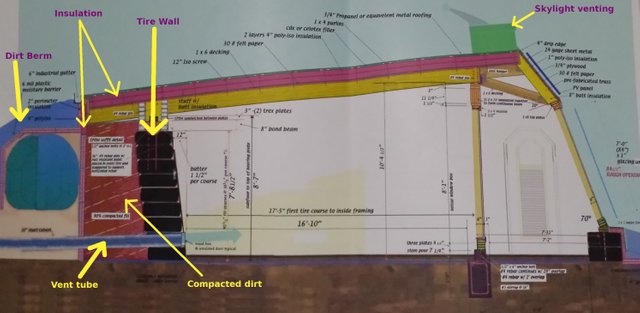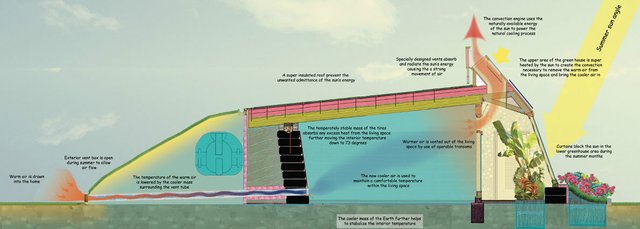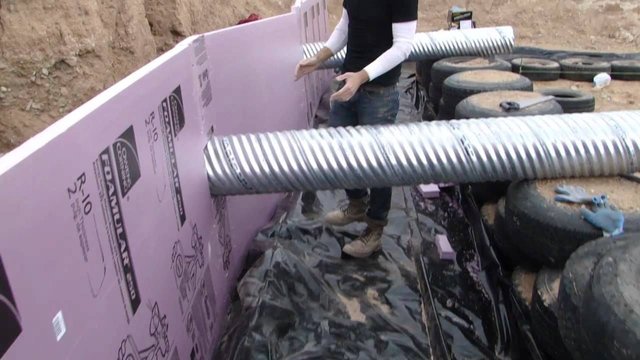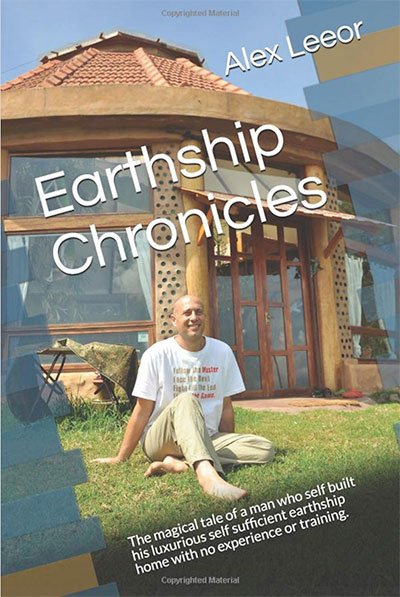Earthship Biotecture Transcribed: Seminar With Michael Reynolds: Part 2
This is part 2 of a transcribed and edited biotecture lecture by Michael Reynolds. If you do read or watch this and have aNY questions please ask in the comments. I am happy to educate and help you to understand this. Biotecture is amazing in so many ways, and even after 20 years I still have not seen a model of sustainable building that even comes close in so many important areas such as performance, carbon footprint, longevity, ease of build, etc. Now you can also come to understand what Biotecture Really Is about!
I have also taken the time to bold any important parts, concepts, and words. It has never been easier to read and understand Biotecture than this, this is like a Biotecture feast!

Earthship Seminar Transcription Part 2
Staying Cool: The Convection Engine
So now... the newer designs which we call the 'global design', is a newer design is.. The a roof is one configuration, one line. That's obviously cheaper. Has a green house here, and this building, see, has a green house, but it has also got a green house here, glass. And... so what that means we're into this thing now we call internal space. Because out here it can be -30(F~-34°C), in this first green house, which you'll see it corner cottage and in the Phoenix and in even the the global models now, it could get down to 45 (F=7°C) or 50 (F=10°C) in here. But this is for plants, not people. But people do hang out there a lot of the time. Then the internal space, this becomes a buffer zone between the outside space and the internal space, people hang out in here and... they are not subject... you know, this buffer zone protects them. It's like a... You rationalize it or, you know, it's square footage you have to pay for it. But it grows plants, it treats sewage, creates more roof space to catch more water and becomes a buffer zone between you and the outside.
Thermal Buffer Zones in extreme climates provide Additional Greenhouse Space.

We even have some where we have gone which have one more, outside. So there's two buffer zones. If in extreme situations. The Phoenix illustrates that a little. We do... We play with all kinds of extremes here, this is a good place to develop these kind of buildings because... we do get seriously cold here, sub-zero, you know, if you're talking in Fahrenheit 30-35 below(-34,-37 °C). And we get up 'til 105 (F=40 °C). So we have to make the buildings cool and warm. But mass is what does that. So now we have taken just this simple thing and made it a little more fine tuned with all of this, quite a bit more actually, of course, there's a super insulation on the roof and... it turns out that these ventilation skylights are... in the winter, that's a cold draft coming down from there no matter how... ...tight you seal it. And so we're trying to buy every degree that we can, so we took them out, And we put them into the green house now. And you'll see this on... Kirsten to point this out on the tour, but look for it.
Now, we have tubes coming through the burial that.... This is called a... this is... This is just been evolved in the last year so in getting better. What happens is in this green house, it gets intensively hot up here. And that heat wants to rise and we have a skylight to let it rise, to let it escape and the hotter it is the faster it goes out of there. When it leaves you can't have a vacuum, so it's gonna create a suction. And what it does then is it sucks air... through... these tubes. And these tubes are buried in the burial

So... It's almost... a convection... ...engine. Convection driven air movement. No fans, nothing. But there is air moving. And... We just did one up in Miles city, Montana. It was 105... It didn't have the double green house, there's a third green house at the double It was a 105 (40 °C) outside, 71 (22°C) inside. And that would have made the law happy. *laughter* You know, people would've sat around this at lunch because they're coming in from working outside in 105° (40°C) and sat around these tubes and put their bottles of water in and all kinds of stuff. You could see it was working. And this is with no fuel!

People would've sat around this at lunch because they're coming in from working outside in 105° (40°C) and sat around these tubes and put their bottles of water in and all kinds of stuff. You could see it was working. And this is with no fuel!
Trapping termperature in tire walls with The Thermal Wrap
So now, we have taken this configuration that we got busted for a decade or so ago, and taken it further, we have removed the heat loss of the skylight created even better ventilation, and... done one more thing. We do now what we call a thermal wrap, and we've got one under construction, called the global, across from the corner cottage, Thermal wrap is where we take rigid insulation and go out another 3 ft(~92 cm) from the tires. And so now... This, we have trapped more actual earth mass to work with the tires.
The tires become the structure and mass, but we're adding another 3 ft(~92 cm) to that mass by isolating it away from the cooler earth. Because, see, it's the cool earth that cools off this air. This air goes through the earth and cools off, well in the winter time when we plug these and the frigid air goes down into the earth 3 or 4 ft (92 or 121 cm) but it can't get through this insulation. So now, there's close to 6-7 ft (182-213 cm) of mass that belongs to this space. And... the way that works in a... It's an actual... I do observe laws of physics, I don't really observe other laws *laughter* But... Laws of physics, I call unarguable and... You know, you can't argue with the sun. It's gonna do what it's gonna do. But anyway, a law of physics is that heat moves to the cooler place. Not vice versa.
So what happens is... when... warm air in the winter, say, it's coming through these green houses It heats up this air space when this mass space is cooler. So the heat leaks into it. And it just stores it because it's trapped by this insulation, this thermal wrap. So this warm air in the space leaks into the walls due to the law of physics. Well, what happens then is... people that stay and we have this nightly rentals that... we use, that's kind of a... It was an accident because, see, the early days Kirsten probably showed you some of the early buildings looked like they landed and whatever... Not marketable buildings. So, I had a bunch of these unmarketable buildings, people wanted to look at them, stay in them, but didn't... certainly didn't want to buy them, and if they did want to buy them the banks wouldn't even consider it anyway.

So, I'm here, I am stuck with mortgage payments on a bunch of weird buildings. And I had to... so, I started to rent them at night to people, and that turned out to save me from going bankrupt, basically. And... so now we do it, but... We do it now to o give people the experience of living in these because... lot of people think if you're gonna be sustainable or green or whatever... you're in a teepee [indian tent] out of the desert. But they don't realize that you can have flat screen TV and... high speed internet and all kinds of goodies, normal life.
So, anyway... the people that stay in the nightly rentals, would come to us and say: 'What the hell is going on?' We go to bed at winter, we went to bed and put blankets on and... you know, the sun went down and the air space got cool so you know, we went to bed and put blankets on... not... It wasn't cold but it was cool enough in the winter to have blanket on. And at midnight, at 1 o'clock they wake up and kicked the blankets off and they said: 'It's like a heating system is coming on or you got something you're not telling us? Or whatever?'
at 1 o'clock they wake up and kicked the blankets off and they said: 'It's like a heating system is coming on or you got something you're not telling us?
So, what's going on is... And they've told us that in many ways, I mean... They've come and actually said: 'What is going on?' 'It felt like a heating system what's coming on at midnight.' So... what is in fact going on is... The sun goes down, the air space in this internal space, the warmth cools down, you know, from heat loss through both glass phases It's slowed down by this, but it still cools off. And eventually in the middle of the night, this space gets down to may be... 69°(~20,5°C) or something, while the walls are stored up at may be 73°(~23°C), and in it's this few degrees different but that's what it takes. May be, this even gets... the air space... the air temperature can even drop to 67(~19°C), or whatever... It's still lower than the temperature in the wall So because of physics, the air starts to leaking out. It's just like turning furnace on. The minute this air space gets lower in temperature then the massive wall, and there's a tremendous amount of mass in a 7 ft (~213 cm) thick wall, all way around your building... The heat starts leaking out. And it just heats up the space. And...
So, that just keeps going off and on. Natural phenomena! So you can see from this building here how we had to handle on it on the very beginning decades ago... But how it's refined in many, many ways now, so. We can keep the space in something like the corner cottage, and it'd be like 73°(~23°C)... And I would say between 70(~21°C) and 75(~24°C) is worth largely were hangs it'd make it up a little higher, a little lower, but it's close enough now, much closer than this building.
See, this tube thing, We... just... we'd been doing it on the tropics, we did it in... India, and Hawaii... Nicaragua... We started doing it in tropics, we weren't even doing it here. But... we started doing it just to cool off in the summers here. And we started doing it here really to create ventilation, without heat loss in the winter. And then we started seeing that totally cool air were just moving through the building. So this refinement, this is really in the last year, year and half. The thermal mass has been around 6 or 4-5 years, something like that. I mean the thermal wrap. The thermal mass was there from the beginning, the buffer zones... they happened in the last... 4-5 years.
So, when you apply all of these tricks, then you end up with a building that is just gonna set there without fuel and take care of you
So, when you apply all of these tricks, then you end up with a building that is just gonna set there without fuel and take care of you. And in... And we have gone through many models, they... the... you know, the earthship designs they have what we call the 'packaged'... and the packaged with the double green house then evolved, which is close to what I'm talking about now, the modular was the circles on the 'U's, and then the hybrid was combination of both, and of course, custom is custom. We can't... no matter how much money you have, we can... I mean, we can make a custom building that's all beautiful and looks a lot more interesting, but we can't really make a building that works better than this one that we call the 'global model' now. And now, this one... is... what we use in the tropics because it stays cool and what we use in the extreme cold.
We do take a little further, and if it's super extreme cold why ain't we add another green house? And... it's easy to justify this, because... like I said the... the second greenhouse is treating sewage, which we are going to tomorrow... it's... growing food, and... creating more roof space to catch more water, creating the convection engine to cause the ventilation, and becoming a buffer zone. You know, it's like tires. There are six reasons to do this. Just like there six reasons to use tires. It's not just one thing and that justifies it. 'Cause people are... you know, when you're paying this cost in this area $205 of ft²(~0,09 m²) That's about what... a good economical, but good conventional building costs here. Adobes in Santa Fe costs $300-350 a ft²(~0,09 m²). And these are better.
So, it's in the price range with regular buildings... in the developed world. And in many places it's... It's allowed in the developed world. But it's... one configuration now that we're using everywhere. These buildings they aren't obviously looking for a plan, I think they've got drawings here of... the studio version, the one bedroom version, the two bedroom version. You'll be on a tour, you'll be able to see the one bedroom version of this, you'll be able to see a three bedroom version of this... under construction, you'll be able to see the... the... out of date version of this which is corner cottage. Which is really a package design with a double greenhouse and... See, we evolved the packaged design more than a decade ago. Just to... to simplify this, because... what we found out was, once we started building these kind of spaces was... still, and it's still true today, the most... prominent selling home, in the United States, is those manufactured houses that they bring in on a truck, setting on concrete blocks, hook 'em up to the utilities and, they start falling apart immediately. *laughter* And they pump fuel into them and water and sewage out of them and... But they are easily available to people. And we... then... you know, over a decade ago started realizing that, we have to make this available to people, it can't be more expensive, it can't be... It has to be something that's even more available to people, because... Money talks, really, and we're trying evolve beyond that in a lot of ways while we're getting into that, but... If you're playing with an idea that has to be purchased then... it's gotta be the same price as the other things on the market.
END OF PART 2
I hope you had a good read! If you would like to watch this then below is a link to part 2. Enjoy! Stay tuned for Part 2, coming soon!
Earthship Seminar Video 2009 - Part 2

READ PREVIOUS TRANSCRIPT
https://steemit.com/ecotrain/@eco-alex/earthship-biotecture-101-learn-with-michael-reynolds-part-1
Did you know, I built four Earthships in India as well as being instrumental the creation of the first Earthship in the UK, Earthship Brighton. If you are also on this path and would like to read my story, I have recently published a book. It is not only a great story, but a valuable resource for you to learn from. I had no experience or training when I embarked on my mission, but managed to successfully build a gorgeous home called Earthship Karuna.
You can buy this book with Steem on the homesteaders co-op. Whilst you are there please do have a look at some of the other proudcts as there are all kinds of great things there!


https://homesteaderscoop.com/product/earthship-chronicles-ebook/
If you don't have any steem you can also buy the ebook and paperback on amazon.
http://mybook.to/Earthship-Chronicles
or
https://www.amazon.com/Earthship-Chronicles-sufficient-luxurious-experience-ebook/dp/B07MYCBXYB
@ecoTrain
Supporting People Who Help
Make The World A Better Place

Discover previous ecoTrain magazines at @ecoTrain
** Click Here To View Our Passenger Feed**


I am going to Binge Watch you while I'm away in Vietnam. LOL.... A cold drink, on my balcony, over-looking the sea.... What more could a girl want than a little 'something' to ignite her dreams while she's resting?? <3
AND I JUST BOUGHT THE BOOK FROM @homesteaderscoop Gonna write about that for my steem post this evening. <3
Obviously u get a 100% upvote for that!
Awesome ;)
LOL.... Much appreciated. :)
To listen to the audio version of this article click on the play image.

Brought to you by @tts. If you find it useful please consider upvoting this reply.
I’m not an engineer, so I don’t understand all the mechanics... but it’s pretty awesome what I do get.
Posted using Partiko iOS
yes it is.. i think next one i will write a commentary with it so i can explain it more
You've been visited by @thistle-rock from Homesteaders Co-op.
This is simply wonderful to see the set up and workings of this concept... and the results... fantastic!
Thank you for sharing.
A community marketplace of ethical, handmade and sustainable products available for STEEM, SBD (and USD): https://homesteaderscoop.com
follow: @homesteaderscoop
This post has been voted on by the SteemSTEM curation team and voting trail. It is elligible for support from @curie.
If you appreciate the work we are doing, then consider supporting our witness stem.witness. Additional witness support to the curie witness would be appreciated as well.
For additional information please join us on the SteemSTEM discord and to get to know the rest of the community!
Please consider setting @steemstem as a beneficiary to your post to get a stronger support.
Please consider using the steemstem.io app to get a stronger support.